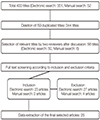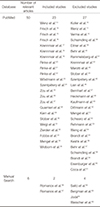1. Weaver JD. Telescopic copings in restorative dentistry. J Prosthet Dent. 1989; 61:429–433.


2. Isaacson GO. Telescope crown retainers for removable partial dentures. J Prosthet Dent. 1969; 22:436–448.


3. Körber KH. Conus crowns: the rational telescope system introduction to clinics and technology [in German]. 5th ed. Heidelberg: Dr. Alfred Hüthig Verlag GmbH;1988. p. 81–86.
4. Körber KH. Cone crowns-a physically defined telescopic system. German Dent J. 1968; 23:619–630.
5. Böttger H, Engelhardt JP. Telescopic system in dental practice [in German]. Quintessenz. 1970; 21:69–72.
6. Engels J, Schubert O, Güth JF, Hoffmann M, Jauernig C, Erdelt K, Stimmelmayr M, Beuer F. Wear behavior of different double-crown systems. Clin Oral Investig. 2013; 17:503–510.


7. Lehmann KM, Gente M. Double crowns used to support removable partial dentures [in German]. German Dent Cal. 1988; 47:106–112.
8. Weber H, Frank G. Spark erosion procedure: a method for extensive combined fixed and removable prosthodontic care. J Prosthet Dent. 1993; 69:222–227.


9. Langer A. Telescope retainers and their clinical application. J Prosthet Dent. 1980; 44:516–522.


10. Koller B, Att W, Strub JR. Survival rates of teeth, implants, and double crown-retained removable dental prostheses: a systematic literature review. Int J Prosthodont. 2011; 24:109–117.

11. Wenz HJ, Lehmann KM. A telescopic crown concept for the restoration of the partially edentulous arch: the Marburg double crown system. Int J Prosthodont. 1998; 11:541–550.

12. Verma R, Joda T, Brägger U, Wittneben JG. A systematic review of the clinical performance of tooth-retained and implant-retained double crown prostheses with a follow-up of ≥ 3 years. J Prosthodont. 2013; 22:2–12.

13. Wenz HJ, Hertrampf K, Lehmann KM. Clinical longevity of removable partial dentures retained by telescopic crowns: outcome of the double crown with clearance fit. Int J Prosthodont. 2001; 14:207–213.

14. Frisch E, Ziebolz D, Rinke S. Long-term results of implant-supported over-dentures retained by double crowns: a practice-based retrospective study after minimally 10 years follow-up. Clin Oral Implants Res. 2013; 24:1281–1287.

15. Frisch E, Ziebolz D, Ratka-Krüger P, Rinke S. Double crown-retained maxillary overdentures: 5-year follow-up. Clin Implant Dent Relat Res. 2015; 17:22–31.


16. Frisch E, Ratka-Krüger P, Wenz HJ. Unsplinted implants and teeth supporting maxillary removable partial dentures retained by telescopic crowns: a retrospective study with >6 years of follow-up. Clin Oral Implants Res. 2015; 26:1091–1097.

17. Krennmair G, Sütö D, Seemann R, Piehslinger E. Removable four implant-supported mandibular overdentures rigidly retained with telescopic crowns or milled bars: a 3-year prospective study. Clin Oral Implants Res. 2012; 23:481–488.


18. Krennmair G, Seemann R, Weinländer M, Piehslinger E. Comparison of ball and telescopic crown attachments in implant-retained mandibular overdentures: a 5-year prospective study. Int J Oral Maxillofac Implants. 2011; 26:598–606.

19. Krennmair G, Krainhöfner M, Waldenberger O, Piehslinger E. Dental implants as strategic supplementary abutments for implant-tooth-supported telescopic crown-retained maxillary dentures: a retrospective follow-up study for up to 9 years. Int J Prosthodont. 2007; 20:617–622.

20. Rinke S, Ziebolz D, Ratka-Krüger P, Frisch E. Clinical outcome of double crown-retained mandibular removable dentures supported by a combination of residual teeth and strategic implants. J Prosthodont. 2015; 24:358–365.


22. Rinke S, Schneider L, Schulz X, Wiedemann V, Bürgers R, Rödiger M. Overdentures borne on less than four abutments with telescopic crowns: 5-year results of a retrospective clinical study. Clin Oral Investig. 2019; 23:3153–3160.


23. Wöstmann B, Balkenhol M, Weber A, Ferger P, Rehmann P. Long-term analysis of telescopic crown retained removable partial dentures: survival and need for maintenance. J Dent. 2007; 35:939–945.


24. Szentpétery V, Lautenschlager C, Setz JM. Frictional telescopic crowns in severely reduced dentitions: a 5-year clinical outcome study. Int J Prosthodont. 2012; 25:217–220.

25. Zou D, Wu Y, Huang W, Zhang Z, Zhang Z. A 5- to 8-year retrospective study comparing the clinical results of implantsupported telescopic crown versus bar overdentures in patients with edentulous maxillae. Int J Oral Maxillofac Implants. 2013; 28:1322–1330.


26. Zou D, Wu Y, Huang W, Wang F, Wang S, Zhang Z, Zhang Z. A 3-year prospective clinical study of telescopic crown, bar, and locator attachments for removable four implant-supported maxillary overdentures. Int J Prosthodont. 2013; 26:566–573.


27. Zou D, Wang F, Wu Y, Huang W, Zhang C, Zhang Z. Implant-supported telescopic crown-retained overdentures for oral rehabilitation of patients with severe bony defects: A 5-year retrospective study. Int J Oral Maxillofac Implants. 2015; 30:937–944.


28. Guarnieri R, Ippoliti S. Restoration of periodontally compromised dentitions using telescopic full-arch retrievable prosthesis supported by tooth-implant combination: A long-term retrospective study. Int J Periodontics Restorative Dent. 2018; 38:217–224.


29. Kern JS, Hanisch O, Hammächer C, Yildirim M, Wolfart S. Telescopic crowns on implants and teeth: Evaluation of a clinical study after 8 to 12 years. Int J Oral Maxillofac Implants. 2019; 34:977–986.


30. Stober T, Bermejo JL, Séché AC, Lehmann F, Rammelsberg P, Bömicke W. Electroplated and cast double crown-retained removable dental prostheses: 6-year results from a randomized clinical trial. Clin Oral Investig. 2015; 19:1129–1136.


31. Weigl P, Trimpou G, Lorenz J, Nentwig GH, Lauer HC. Prefabricated taper crowns for the retention of implant superstructures: Three-year results of a prospective clinical trial. J Prosthet Dent. 2019; 121:618–622.


32. Zierden K, Kurzrock L, Wöstmann B, Rehmann P. Nonprecious alloy vs precious alloy telescopic crown-retained removable partial dentures: Survival and maintenance needs. Int J Prosthodont. 2018; 31:459–464.


33. Fobbe H, Rammelsberg P, Lorenzo Bermejo J, Kappel S. The up-to-11-year survival and success of implants and abutment teeth under solely implant-supported and combined tooth-implant-supported double crown-retained removable dentures. Clin Oral Implants Res. 2019; 30:1134–1141.


34. Mengel R, Wendt J, Peleska B. Prosthodontic treatment outcomes in periodontally compromised patients: A 6- to 20-year long-term cohort study. Int J Prosthodont. 2019; 32:153–161.


35. Widbom T, Löfquist L, Widbom C, Söderfeldt B, Kronström M. Tooth-supported telescopic crown-retained dentures: an up to 9-year retrospective clinical follow-up study. Int J Prosthodont. 2004; 17:29–34.

36. Romanos GE, May S, May D. Immediate loading of tooth-implant-supported telescopic mandibular prostheses. Int J Oral Maxillofac Implants. 2012; 27:1534–1540.

37. Romanos GE, May S, May D. Implant-supporting telescopic maxillary prostheses and immediate loading. Clin Implant Dent Relat Res. 2014; 16:412–418.

38. Schwindling FS, Dittmann B, Rammelsberg P. Double-crown-retained removable dental prostheses: a retrospective study of survival and complications. J Prosthet Dent. 2014; 112:488–493.


39. Eitner S, Schlegel A, Emeka N, Holst S, Will J, Hamel J. Comparing bar and double-crown attachments in implant-retained prosthetic reconstruction: a follow-up investigation. Clin Oral Implants Res. 2008; 19:530–537.


40. Behr M, Kolbeck C, Lang R, Hahnel S, Dirschl L, Handel G. Clinical performance of cements as luting agents for telescopic double crown-retained removable partial and complete overdentures. Int J Prosthodont. 2009; 22:479–487.
41. Rammelsberg P, Bernhart G, Lorenzo Bermejo J, Schmitter M, Schwarz S. Prognosis of implants and abutment teeth under combined tooth-implant-supported and solely implant-supported double-crown-retained removable dental prostheses. Clin Oral Implants Res. 2014; 25:813–818.


42. Krennmair G, Weinländer M, Krainhöfner M, Piehslinger E. Implant-supported mandibular overdentures retained with ball or telescopic crown attachments: a 3-year prospective study. Int J Prosthodont. 2006; 19:164–170.

43. Marotti J, Gatzweiler B, Wolfart M, Sasse M, Kern M, Wolfart S. Implant Placement under Existing Removable Dental Prostheses and the Effect on Follow-Up and Prosthetic Maintenance. J Prosthodont. 2019; 28:e752–e763.

44. Stober T, Bermejo JL, Beck-Mussoter J, Seche AC, Lehmann F, Koob J, Rammelsberg P. Clinical performance of conical and electroplated telescopic double crown-retained partial dentures: a randomized clinical study. Int J Prosthodont. 2012; 25:209–216.

45. Szentpétery V, Lautenschläger C, Setz JM. Longevity of frictional telescopic crowns in the severely reduced dentition: 3-year results of a longitudinal prospective clinical study. Quintessence Int. 2010; 41:749–758.

46. Lian M, Zhao K, Feng Y, Yao Q. Prognosis of combining remaining teeth and implants in double-crown-retained removable dental prostheses: A systematic review and meta-analysis. Int J Oral Maxillofac Implants. 2018; 33:281–297.


47. Bernhart G, Koob A, Schmitter M, Gabbert O, Stober T, Rammelsberg P. Clinical success of implant-supported and tooth-implant-supported double crown-retained dentures. Clin Oral Investig. 2012; 16:1031–1037.


48. Heckmann SM, Schrott A, Graef F, Wichmann MG, Weber HP. Mandibular two-implant telescopic overdentures. Clin Oral Implants Res. 2004; 15:560–569.

49. Kaufmann R, Friedli M, Hug S, Mericske-Stern R. Removable dentures with implant support in strategic positions followed for up to 8 years. Int J Prosthodont. 2009; 22:233–241. discussion 242.

50. Dittmann B, Rammelsberg P. Survival of abutment teeth used for telescopic abutment retainers in removable partial dentures. Int J Prosthodont. 2008; 21:319–321.

51. Mengel R, Kreuzer G, Lehmann KM, Flores-de-Jacoby L. A telescopic crown concept for the restoration of partially edentulous patients with aggressive generalized periodontitis: a 3-year prospective longitudinal study. Int J Periodontics Restorative Dent. 2007; 27:231–239.

52. Schwarz S, Bernhart G, Hassel AJ, Rammelsberg P. Survival of double-crown-retained dentures either tooth-implant or solely implant-supported: an 8-year retrospective study. Clin Implant Dent Relat Res. 2014; 16:618–625.


53. Rehmann P, Rudel K, Podhorsky A, Wöstmann B. Three-year analysis of fixed and removable telescopic attachment-retained implant-supported dental prostheses: Survival and need for maintenance. Int J Oral Maxillofac Implants. 2015; 30:918–924.


54. Weng D, Richter EJ. Maxillary removable prostheses retained by telescopic crowns on two implants or two canines. Int J Periodontics Restorative Dent. 2007; 27:35–41.

55. Brandt S, Brandt J, Ketabi AR, Lauer HC, Kunzmann A. Locator® versus ceramic/electroplated double-crown attachments: a prospective study on the intraindividual comparison of implant-supported mandibular prostheses. Clin Oral Investig. 2019; 23:763–770.


57. Behr M, Hofmann E, Rosentritt M, Lang R, Handel G. Technical failure rates of double crown-retained removable partial dentures. Clin Oral Investig. 2000; 4:87–90.


58. Schwindling FS, Dittmann B, Rammelsberg P. Double-crown-retained removable dental prostheses: a retrospective study of survival and complications. J Prosthet Dent. 2014; 112:488–493.


59. Brandt S, Winter A, Weigl P, Brandt J, Romanos G, Lauer HC. Conical zirconia telescoping into electroformed gold: A retrospective study of prostheses supported by teeth and/or implants. Clin Implant Dent Relat Res. 2019; 21:317–323.


60. Eisenburger M, Gray G, Tschernitschek H. Long-term results of telescopic crown retained dentures-a retrospective study. Eur J Prosthodont Restor Dent. 2000; 8:87–91.

61. Coca I, Lotzmann U, Pöggeler R. Long-term experience with telescopically retained overdentures (double crown technique). Eur J Prosthodont Restor Dent. 2000; 8:33–37.

62. Saito M, Notani K, Miura Y, Kawasaki T. Complications and failures in removable partial dentures: a clinical evaluation. J Oral Rehabil. 2002; 29:627–633.


63. Bergman B, Ericson A, Molin M. Long-term clinical results after treatment with conical crown-retained dentures. Int J Prosthodont. 1996; 9:533–538.

64. Joda T. Combined tooth-implant-supported telescopic prostheses in a midterm follow-up of > 2 years. Int J Prosthodont. 2013; 26:536–540.

65. Weischer T, Mohr C. Implant-supported mandibular telescopic prostheses in oral cancer patients: an up to 9-year retrospective study. Int J Prosthodont. 2001; 14:329–334.

66. Ishida K, Nogawa T, Takayama Y, Saito M, Yokoyama A. Prognosis of double crown-retained removable dental prostheses compared with clasp-retained removable dental prostheses: A retrospective study. J Prosthodont Res. 2017; 61:268–275.


67. Lin CL, Wang JC, Chang WJ. Biomechanical interactions in tooth-implant-supported fixed partial dentures with variations in the number of splinted teeth and connector type: a finite element analysis. Clin Oral Implants Res. 2008; 19:107–117.


68. Michalakis KX, Calvani P, Hirayama H. Biomechanical considerations on tooth-implant supported fixed partial dentures. J Dent Biomech. 2012; 3:1758736012462025.

69. Koosha S, Mirhashemi FS. An Investigation of Three types of Tooth Implant Supported Fixed Prosthesis Designs with 3D Finite Element Analysis. J Dent (Tehran). 2013; 10:51–63.


70. Chen Y, Wang C, Huang Y, Feng T, Zou H, Fan Y. Biomechanical evaluation of the natural abutment teeth in combined toothimplant-supported telescopic prostheses: a three-dimensional finite element analysis. Comput Methods Biomech Biomed Engin. 2017; 20:967–979.


71. Mock F, Schrenker H, Stark HK. Success of telescopic crowns-a prospective long-term study [in German]. German Dent J. 2005; 60:148–153.




 PDF
PDF ePub
ePub Citation
Citation Print
Print
















 XML Download
XML Download